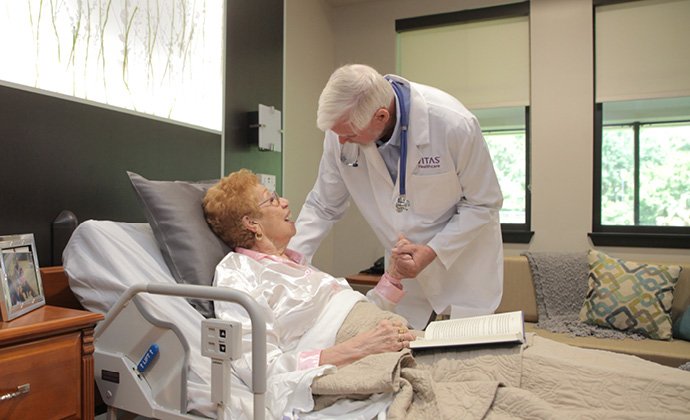Inpatient Hospice Care
When Symptoms Can't Be Managed at Home
Most of the time, hospice care is brought to the patient at home, since home is where most seriously ill people want to be: in familiar surroundings with familiar routines and familiar faces.
All hospices also must offer inpatient care for help in the assessment and management of acute, complex, or uncontrolled symptoms such as pain or shortness of breath that cannot be provided at home or in other settings.
Meet the VITAS Inpatient Team

Team Manager
The team manager oversees all patient care in the inpatient hospice unit.
Physician
The physician closely monitors the progression of the patient’s illness, prescribes appropriate medications and coordinates care with other members of the team.
Hospice Nurse
The hospice nurse is skilled in assessing and managing pain and other symptoms. A nurse may also help with personal care.
Social Worker
The social worker acts as a friendly and skilled listener and provides emotional support.
Chaplain
The chaplain ministers to the spiritual needs of patients and families of all faiths, and can work with their clergy.
Bereavement Specialist
The bereavement specialist provides grief and loss support to the patient's loved ones.
Volunteer
The hospice volunteer can bring music or a Paw Pals animal companion, and spends quality time with the patient and family.What Qualifies for Inpatient Hospice Care?
Indications of the need for inpatient hospice care may include:
- Sudden deterioration requiring intensive nursing intervention
- Uncontrolled pain
- Uncontrolled nausea and vomiting
- Pathological fractures
- Respiratory distress that becomes unmanageable
- Symptom relief via intravenous medications that require close monitoring
- Wound care requiring complex and/or frequent dressing changes that cannot be managed in the patient’s residence
- Unmanageable agitation or restlessness that requires intensive intervention
- Uncontrolled seizures
- Minor procedures to aid in the comfort of the patient, such as removing fluid from the belly area (paracentesis) or inserting a permanent drain or tube
Where Is Inpatient Hospice Care Provided?

VITAS provides inpatient care in different locations that can provide around-the-clock clinical care. VITAS provides inpatient care in its own licensed freestanding inpatient unit, or in shared space of a separate facility, such as a hospital or skilled nursing facility.
VITAS patients in inpatient locations are cared for primarily by VITAS staff. Physicians and nurses provide care, and integrated staff members—from social worker to chaplain to music therapist—see assigned patients. Families are included in our care. Staff get to know loved ones. They may help out-of-towners navigate the area or welcome the visit of a beloved pet. They enhance quality of life for patients and families.
Some inpatient locations are designed and decorated with hospice patients and families in mind and offer amenities like family rooms, kitchens, and children’s play areas. There are places for quiet contemplation or prayer, and spaces that accommodate the needs of multiple generations. A cup of coffee and facilities to reheat a home-cooked meal are always available. The focus is on comfort and dignity, even when intensive care is necessary, so patients feel at ease.
Day and night, family members and friends of all ages are welcome, and arrangements may be made for overnight stays.
But make no mistake: Intensive pain and symptom management is at work, with a goal of stabilizing the patient so they can return home to routine hospice care.
The inpatient hospice care team:
- Evaluates symptoms
- Provides intensive symptom management
- Maintains around-the-clock care and regular visits
As a result, the team is generally able to manage and control the patient’s symptoms in a relatively short time, usually in days, and the patient can return home.
Contact the VITAS care team near you.
Hospice Care in Hospitals and Nursing Homes
Certain hospice-eligible patients who are already admitted to a hospital or nursing home for acute care cannot be safely relocated to home or inpatient care. In these cases, VITAS works with the patient’s facility and attending staff to coordinate comfort-focused care, manage symptoms, and–when possible–arrange smooth transitions to the patient’s preferred setting.
Whether in a hospital or skilled nursing facility, a VITAS care team supports staff in providing intensive care for patients who face hard-to-manage symptoms, freeing staff for other duties. Facility staff can also turn to VITAS for clinical guidance and education on end-of-life care, as well as assistance with medication management.
Inpatient Care: One of the Four Levels of Care
Whatever the surroundings, 24-hour inpatient care is one of the mandatory levels of hospice care, available when symptoms cannot be controlled per Medicare guidelines. Some patients may need the inpatient level of care to help them transition from hospitalized curative care to home hospice. Others receiving routine home care may have symptoms that become exacerbated.
In either case, the patient usually receives inpatient care for a short period of time (3–5 days) until symptoms are under control, then returns home to the routine level of hospice care.
VITAS offers four broad types, or levels, of care as defined by the Medicare hospice benefit:
- Routine home care: Most of the time, care is provided in the home setting, whether your home is a private residence/home, a nursing home or an assisted living community. VITAS staff members visit regularly, and VITAS provides all medical equipment, supplies and medications related to your diagnosis.
- Continuous home care (Intensive Comfort Care®): When your symptoms cannot be managed on a routine level of care, VITAS has the ability to provide intensive symptom management in the location at which you are already receiving care, until those symptoms are controlled per Medicare guidelines. Nurses and aides provide shifts up to 24 hours of continuous care in your preferred setting of care, allowing you to remain there as long as care can be provided safely and effectively.
- General inpatient care: When your symptoms or pain cannot be managed in the homecare setting, and you do not wish to receive Intensive Comfort Care® at home, VITAS can provide a higher level of specialized care in an inpatient setting until those symptoms are controlled per Medicare guidelines. General Inpatient Care may be provided in a variety of locations, such as a VITAS inpatient hospice unit or in a partnered inpatient care setting, such as a hospital or nursing home.
- Respite care: If needed, VITAS cares for you in an inpatient setting for up to five consecutive days to give your caregiver or family member a needed “respite” or break.
